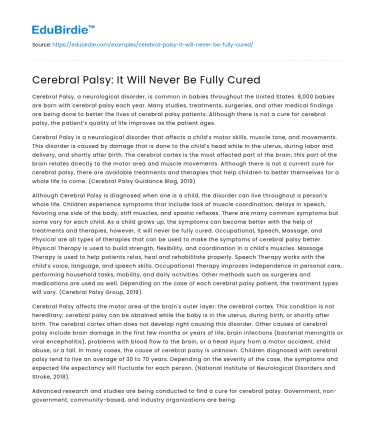Cerebral Palsy, a neurological disorder, is common in babies throughout the United States. 8,000 babies are born with cerebral palsy each year. Many studies, treatments, surgeries, and other medical findings are being done to better the lives of cerebral palsy patients. Although there is not a cure for cerebral palsy, the patient’s quality of life improves as the patient ages.
Cerebral Palsy is a neurological disorder that affects a child’s motor skills, muscle tone, and movements. This disorder is caused by damage that is done to the child’s head while in the uterus, during labor and delivery, and shortly after birth. The cerebral cortex is the most affected part of the brain; this part of the brain relates directly to the motor area and muscle movements. Although there is not a current cure for cerebral palsy, there are available treatments and therapies that help children to better themselves for a whole life to come. (Cerebral Palsy Guidance Blog, 2019)
Save your time!
We can take care of your essay
- Proper editing and formatting
- Free revision, title page, and bibliography
- Flexible prices and money-back guarantee
Although Cerebral Palsy is diagnosed when one is a child, the disorder can live throughout a person’s whole life. Children experience symptoms that include lack of muscle coordination, delays in speech, favoring one side of the body, stiff muscles, and spastic reflexes. There are many common symptoms but some vary for each child. As a child grows up, the symptoms can become better with the help of treatments and therapies, however, it will never be fully cured. Occupational, Speech, Massage, and Physical are all types of therapies that can be used to make the symptoms of cerebral palsy better. Physical Therapy is used to build strength, flexibility, and coordination in a child’s muscles. Massage Therapy is used to help patients relax, heal and rehabilitate properly. Speech Therapy works with the child’s voice, language, and speech skills. Occupational Therapy improves independence in personal care, performing household tasks, mobility, and daily activities. Other methods such as surgeries and medications are used as well. Depending on the case of each cerebral palsy patient, the treatment types will vary. (Cerebral Palsy Group, 2019).
Cerebral Palsy affects the motor area of the brain's outer layer: the cerebral cortex. This condition is not hereditary; cerebral palsy can be obtained while the baby is in the uterus, during birth, or shortly after birth. The cerebral cortex often does not develop right causing this disorder. Other causes of cerebral palsy include brain damage in the first few months or years of life, brain infections (bacterial meningitis or viral encephalitis), problems with blood flow to the brain, or a head injury from a motor accident, child abuse, or a fall. In many cases, the cause of cerebral palsy is unknown. Children diagnosed with cerebral palsy tend to live an average of 30 to 70 years. Depending on the severity of the case, the symptoms and expected life expectancy will fluctuate for each person. (National Institute of Neurological Disorders and Stroke, 2018).
Advanced research and studies are being conducted to find a cure for cerebral palsy. Government, non-government, community-based, and industry organizations are being funded to work for a cure. Research is also being performed on treatment and therapy options. Until there is a cure for this disorder, scientists want to make the symptoms better for each patient. Some types of experiments are stem cell treatments, repairing damaged brain cells, pain management, bio-medical advancements, assistive technology and surveillance. Neurologist Evan Snyder, from Harvard Medical School, injected mice with stem cell implants. This study proved that missing brain cells can be replaced. The study is still being questioned if stem cell implants can be injected into children’s brains. If scientists are able to make the damaged brain cells repair themselves, cerebral palsy could be cured or reversed. Outside of the United States, the United Nations organization is also conducting research. Many different organizations from around the world are conducting research and experiments to cure the same disorder. (Cerebralpalsy.org, 2019).
Cerebral Palsy is a neurological disorder that is caused by damage to the cerebral cortex of the brain. Although this disorder is not hereditary, it is often diagnosed before the child is born. A cure is not yet available for cerebral palsy; however, research is being done all over the world to discover one. Many different types of therapies, medications, and surgeries are available to children and adults diagnosed with this condition. Each case of cerebral palsy can have a different level of severity of symptoms. To this day, people affected by cerebral palsy can still live a good quality of life.






 Stuck on your essay?
Stuck on your essay?

